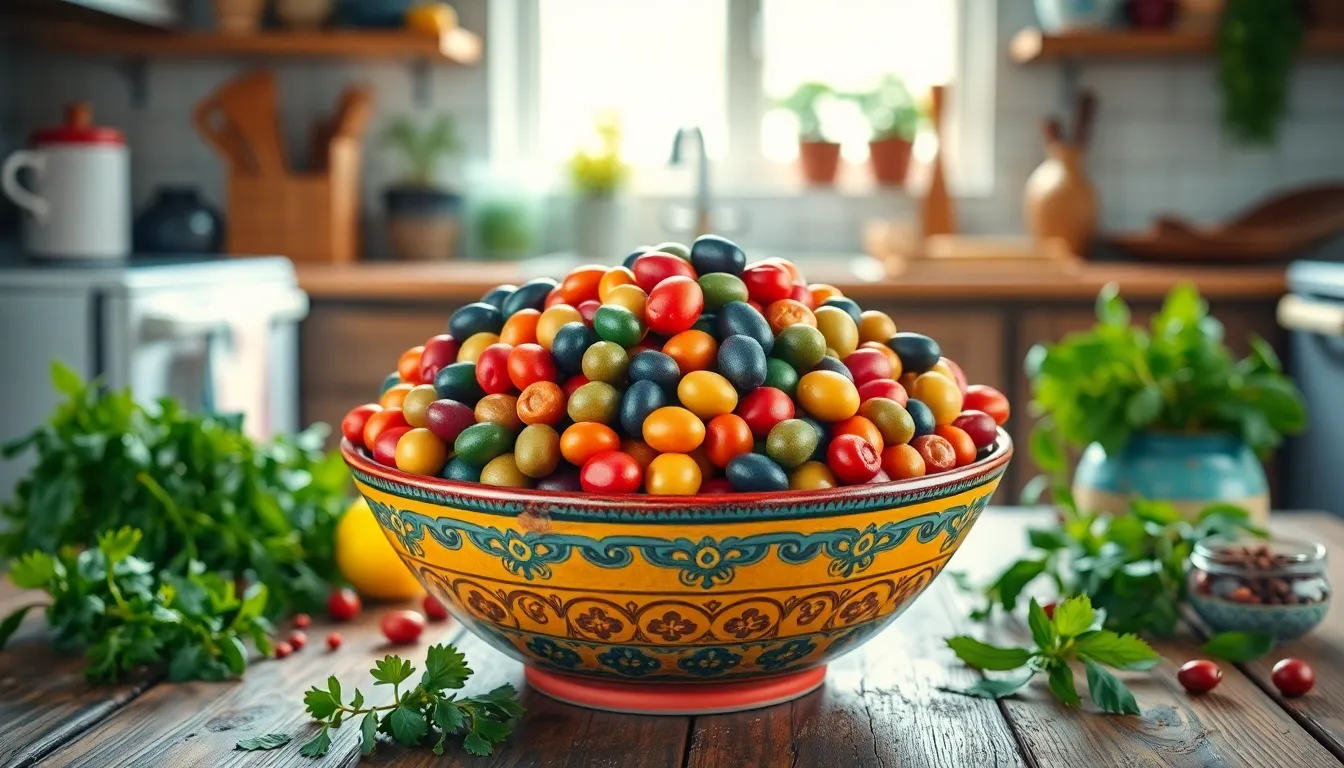Italian cooking isn’t just about tossing a few ingredients together; it’s an art form that transforms simple meals into culinary masterpieces. Picture this: a sizzling pan of garlic and olive oil, fragrant herbs wafting through the air, and the promise of a delicious meal that could make even a nonna shed a tear. Mastering Italian cooking techniques opens the door to a world of flavors that can make any home chef feel like a Michelin-starred pro.
Table of Contents
ToggleOverview Of Italian Cooking Techniques
Italian cooking techniques showcase a range of methods that enhance flavors and textures. Sautéing remains essential, as it develops depth through high heat, often used for garlic and vegetables. Braising involves slow cooking in liquid, creating tender meat dishes, like osso buco, which absorb rich flavors.
Roasting is popular for vegetables and meats alike, allowing natural sugars to caramelize and develop smoky undertones. Grilling infuses dishes with a distinct charred taste, making it a favored choice for vegetables, seafood, and meats. Frying brings crispness, particularly in dishes like arancini, where rice balls turn golden and crunchy.
Pasta-making showcases the craft of cooking, with techniques ranging from rolling dough by hand to using machines for various shapes. Risotto demands careful attention, mixing rice with broth gradually, resulting in a creamy, satisfying texture.
Baking holds its place in Italian cuisine as well, with focaccia and pizza embodying the perfect blend of a chewy base and flavorful toppings. Combining these techniques allows chefs to adapt traditional recipes while exploring creative combinations.
Each technique contributes to the overall experience, reinforcing the idea that good Italian cooking balances simplicity with skill. Using fresh ingredients enhances every method, ensuring that the natural flavors shine through in every dish. Chefs embrace these diverse methods, allowing them to create vibrant meals that celebrate Italy’s culinary heritage.
Traditional Methods
Italian cooking emphasizes traditional techniques that enhance flavor and texture. These methods highlight quality ingredients and foster a connection to Italy’s culinary heritage.
Fresh Pasta Making
Fresh pasta making relies on simplicity and quality ingredients. Flour, eggs, and a dash of salt form the base of this technique. Chefs knead the dough until smooth, then roll it thin using a pasta machine or by hand. Shapes like tagliatelle, ravioli, and lasagna emerge from this delicate process. Fresh pasta cooks quickly, absorbing sauce beautifully, which creates a distinct taste and texture. The tradition of making pasta by hand celebrates family and culture, making it an essential skill for home cooks.
Risotto Techniques
Risotto techniques elevate rice to create creamy, flavorful dishes. Arborio rice, known for its high starch content, absorbs liquid while releasing creaminess. Chefs begin by toasting the rice in olive oil or butter, enhancing its nuttiness. Gradually adding warm stock allows for even cooking and balanced flavor. Constant stirring ensures a creamy consistency, keeping the grains separate yet cohesive. Common additions include mushrooms, saffron, or seafood, each bringing unique flavors to the dish. This method showcases the beauty of patience and skill in Italian cooking.
Sauces And Seasonings
Italian cooking centers on the art of sauces and seasonings, crucial elements that elevate dishes. Mastering these components enhances flavor profiles and creates a true culinary experience.
Importance Of Olive Oil
Olive oil serves as a cornerstone in Italian cuisine, offering rich flavors and health benefits. It acts as a primary fat for sautéing and dressing salads while adding depth to sauces. Fresher oils possess a fruity aroma, contributing to heightened taste complexity. High-quality varieties come from specific regions, such as extra virgin olive oil from Tuscany. Benefits include anti-inflammatory properties and heart health, making it a preferred choice among home chefs. It enriches marinades and preserves freshness in vegetables and meats, underscoring its versatility.
Creating The Perfect Marinara
Creating the perfect marinara sauce relies on quality ingredients and technique. Start with ripe tomatoes, whether San Marzano or fresh garden varieties, to provide a robust base. Sauté garlic in olive oil, allowing flavors to meld before adding tomatoes. Simmer gently, letting the sauce thicken and deepen in flavor. Herbs like basil and oregano enhance freshness, while a pinch of sugar balances acidity. Unlike many sauces, marinara boasts simplicity and allows for personal twists with additional ingredients, such as olives or red pepper flakes. This quintessential sauce exemplifies Italian cooking’s dedication to flavor and tradition.
Baking And Roasting
Baking and roasting are fundamental techniques in Italian cooking that enhance flavors and textures. These methods transform simple ingredients into mouthwatering dishes.
Bread Making Essentials
Bread making stands as a cornerstone of Italian cuisine. Ingredients such as flour, water, yeast, and salt form the base for a variety of bread types, including focaccia and ciabatta. To create perfect dough, knead until smooth, allowing gluten to develop for the ideal texture. Allowing the dough to rise in a warm environment encourages proper fermentation, resulting in airy loaves. Once baked, the crust should be golden brown, while the interior remains soft and chewy.
Roasting Meats And Vegetables
Roasting meats and vegetables showcases the vibrancy of Italian cooking. Choosing quality cuts, such as lamb or pork, elevates the dish’s flavor. Season meats generously with herbs like rosemary and thyme before placing them in the oven. Vegetables, such as bell peppers and zucchini, benefit from high heat, caramelizing their natural sugars for rich flavors. The roasting process imbues dishes with an irresistible aroma, enhancing overall enjoyment. Allow meals to rest post-roasting, ensuring the juices redistribute for maximum tenderness.
Modern Adaptations
Modern adaptations of Italian cooking reflect a blend of tradition and innovation. Chefs creatively combine flavors and techniques, resulting in dishes that capture Italian heritage while incorporating global influences.
Fusion Italian Dishes
Fusion Italian dishes represent a growing trend in culinary arts. Ingredients from diverse cultures, such as spicy Asian sauces or locally sourced produce, infuse traditional recipes. For example, dishes like sushi pizza merge Italian and Japanese elements, showcasing unique flavor combinations. The result remains true to the essence of Italian cooking while introducing exciting, unexpected twists.
Technology In Italian Cooking
Technology shapes contemporary Italian cooking, improving efficiency and precision. Sous-vide cooking techniques offer chefs consistent results by maintaining exact temperatures for long periods. Additionally, apps that track ingredient freshness assist in minimizing waste and maximizing flavor. Smart appliances streamline the preparation process, allowing home cooks to replicate complex recipes easily. These advancements maintain the authenticity of Italian cuisine while enhancing the overall cooking experience.
Italian cooking techniques embody a rich tapestry of flavors and traditions. By embracing methods like sautéing and pasta-making, home chefs can not only enhance their culinary skills but also connect with Italy’s vibrant heritage. The emphasis on fresh ingredients and simplicity allows for a genuine expression of creativity in the kitchen.
As modern influences intertwine with traditional practices, the essence of Italian cuisine remains intact. Whether through innovative dishes or the use of technology, the heart of Italian cooking continues to inspire. With each technique mastered, chefs can create memorable meals that celebrate the joy of cooking and the love for food.




